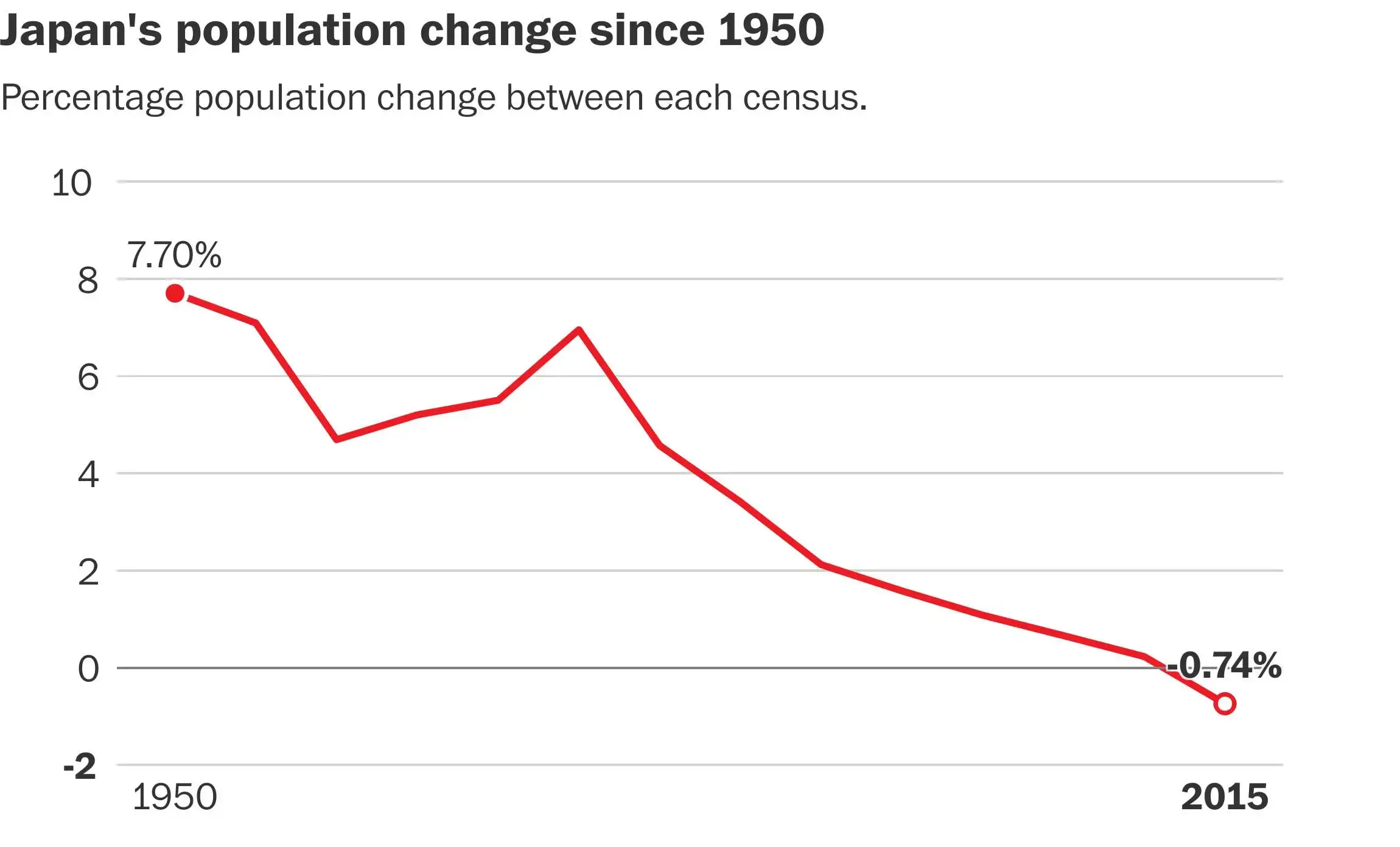
Table of Contents
- 1 Factors Contributing to Japan’s Population Decline
- 2 Demographic Challenges Facing Japan
- 3 Economic Impact of Japan’s Declining Population
- 4 Government Policies Addressing the Population Crisis
- 5 Solutions to Japan’s Population Decline
- 6 Initiatives to Encourage Immigration to Japan
- 7 Case Studies of Countries Facing Similar Population Challenges
- 8 Lessons Learned from Other Countries’ Approaches
- 9 Future Outlook for Japan’s Population Crisis
Japan is facing an unprecedented population crisis that has far-reaching implications for its economy and society. With a stagnant birth rate and an aging population, the country is grappling with a severe shortage of young workers and an increasing burden on its healthcare and social welfare systems. Over the past few decades, Japan’s fertility rate has plummeted to one of the lowest in the world, while life expectancy continues to rise. As a result, the proportion of people aged 65 and above is rapidly increasing, leading to a demographic imbalance that threatens long-term economic growth.
This article delves into the causes of Japan’s population crisis and explores the potential consequences for the country’s economy and social fabric. It also examines the government’s efforts to address the issue and outlines possible solutions to reverse the declining birth rate and support sustainable population growth. In a country known for its technological prowess and innovative solutions, the challenge now lies in finding creative ways to revitalize Japan’s population and secure its future.
Factors Contributing to Japan’s Population Decline
Japan’s population decline can be attributed to several key factors. One of the primary causes is the country’s declining birth rate. The fertility rate in Japan has dropped significantly over the years, with women choosing to have fewer children or delaying starting a family altogether. This decline can be attributed to various societal and economic factors, including changing gender roles, increased education and career opportunities for women, and the high cost of raising children in urban areas. Additionally, the preference for smaller families and a shift towards individualistic values have also played a role in the decreasing birth rate.
Another contributing factor to Japan’s population decline is the country’s rapidly aging population. Japan has one of the highest life expectancies in the world, with people living longer than ever before. While this is a testament to the country’s advancements in healthcare and quality of life, it also poses significant challenges. A growing elderly population means fewer working-age individuals to support the economy and an increased strain on social welfare systems and healthcare services. This demographic shift has major implications for the country’s economic growth and sustainability.
Furthermore, lunatogel Japan’s population decline is exacerbated by a lack of immigration. Unlike many other developed countries, Japan has historically been resistant to accepting immigrants, leading to limited population growth through immigration. The country’s strict immigration policies and cultural homogeneity have made it difficult for foreign individuals to settle and contribute to the workforce. As a result, Japan has missed out on the economic and social benefits that immigration can bring, such as increased labor force participation and cultural diversity.

Demographic Challenges Facing Japan
Japan’s aging population presents a multitude of challenges for the country. One of the most pressing concerns is the shrinking labor force. As the number of elderly individuals increases, there are fewer young people entering the workforce to replace retirees. This imbalance not only poses a threat to economic productivity but also puts a strain on the pension and social security systems. With a smaller working-age population contributing to these systems, it becomes increasingly difficult to sustain the growing number of elderly individuals who rely on them.
Another significant challenge is the burden on healthcare and social welfare systems. With a larger proportion of the population requiring medical care and support in their old age, Japan’s healthcare system is under immense pressure. The cost of providing healthcare for the elderly is skyrocketing, and finding enough healthcare professionals to cater to their needs is becoming increasingly challenging. Additionally, the social welfare system is stretched thin, with limited resources available to support the growing number of elderly individuals who may require financial assistance or long-term care.
The aging population also has implications for the housing market and infrastructure. As more elderly individuals choose to age in place, there is a growing demand for accessible housing and infrastructure that caters to their needs. Retrofitting existing buildings and creating age-friendly communities require significant investments and planning to ensure that the aging population can live comfortably and independently.
Economic Impact of Japan’s Declining Population
Japan’s declining population has significant economic implications. With a shrinking labor force, the country faces labor shortages in various industries. This shortage of workers can hinder economic growth and innovation, as businesses struggle to find skilled employees to fill vacant positions. Additionally, the decline in consumer spending due to an aging population can negatively impact industries such as retail and entertainment. With fewer young consumers, businesses must adapt their strategies to cater to the changing demographic landscape.
Furthermore, the declining population puts a strain on public finances. As the number of elderly individuals increases, the government’s spending on healthcare, pensions, and social welfare programs escalates. This increased expenditure, coupled with a smaller tax base, creates fiscal challenges and may necessitate tax reforms or reductions in public spending in other areas.
The declining population also has implications for the housing market and real estate sector. With a shrinking population, there is less demand for housing, particularly in rural areas. This can lead to a decline in property values and a decrease in construction activity, impacting industries related to real estate and construction.
Government Policies Addressing the Population Crisis
The Japanese government has recognized the severity of the population crisis and has implemented various policies to address the issue. One such policy is the promotion of work-life balance and support for working parents. The government has introduced measures to encourage companies to provide flexible working arrangements and childcare support, making it easier for individuals to balance work and family responsibilities. These initiatives aim to alleviate the financial and logistical challenges associated with raising children and encourage couples to have more children.
Another key government policy is the expansion of childcare facilities and support for early childhood education. By increasing the availability of affordable and high-quality childcare, the government aims to reduce the burden on families and create a more supportive environment for working parents. These efforts aim to encourage couples to have children by providing the necessary infrastructure and support systems.
Furthermore, the government has introduced initiatives to encourage elderly individuals to remain in the workforce for longer. By raising the retirement age and promoting the hiring of older workers, the government hopes to address labor shortages and ensure the continued contribution of experienced individuals to the economy. These policies also aim to alleviate the strain on social welfare systems by reducing the number of individuals relying on pensions and other forms of financial support.

Solutions to Japan’s Population Decline
In addition to government policies, there are several other solutions that can help address Japan’s population decline. One potential solution is to incentivize childbirth through financial incentives and support systems. Providing financial assistance to families with children, such as child allowances and tax credits, can alleviate the financial burden of raising children and make it more appealing for couples to start a family. Additionally, improving access to affordable housing and healthcare for families can further support population growth.
Another solution is to encourage immigration and create a more inclusive society. By relaxing immigration policies and creating pathways for foreign individuals to work and settle in Japan, the country can benefit from the skills and contributions of a diverse workforce. This can help address labor shortages and stimulate economic growth. Creating a welcoming and inclusive society for immigrants is crucial to ensure their successful integration and long-term contribution.
Investing in technological advancements and automation can also help mitigate the impact of a declining population. By embracing automation and artificial intelligence, Japan can increase productivity and efficiency in various industries, reducing the dependence on a large labor force. This can help offset the effects of a shrinking workforce and ensure continued economic growth.
Initiatives to Encourage Immigration to Japan
To address the declining population and labor shortages, Japan has started implementing initiatives to encourage immigration. One such initiative is the introduction of a new visa system that allows foreign workers to enter Japan for specified periods to address labor shortages in specific industries. This system aims to attract skilled workers from countries such as Vietnam, the Philippines, and Indonesia, who can contribute to sectors such as agriculture, construction, and nursing care.
Additionally, Japan has implemented policies to attract highly skilled foreign professionals, such as scientists, engineers, and researchers. The government offers streamlined visa procedures and support services to facilitate their entry and integration into the Japanese workforce. By attracting talent from around the world, Japan can benefit from their expertise and contribute to technological advancements and innovation.
Case Studies of Countries Facing Similar Population Challenges
Japan is not the only country facing a population crisis. Several other countries, such as South Korea and Germany, are also grappling with declining birth rates and aging populations. Examining these case studies can provide valuable insights into the challenges and potential solutions for addressing population decline.
South Korea, for example, has implemented policies to address its declining birth rate, including financial incentives for childbirth and support for working parents. The country has also focused on improving gender equality and work-life balance to encourage individuals to start families. Additionally, South Korea has actively promoted immigration, particularly through the introduction of a points-based system for skilled foreign workers.
Germany, on the other hand, has taken a different approach to address its population decline. The country has implemented policies to attract skilled workers from other European Union countries and beyond. Germany’s immigration policies focus on attracting individuals with specific skills and qualifications to meet labor market demands. Additionally, the government has invested in education and vocational training to bridge the skills gap and ensure a skilled workforce for the future.

Lessons Learned from Other Countries’ Approaches
The experiences of countries like South Korea and Germany provide valuable lessons for Japan in tackling its population decline. One key lesson is the importance of a comprehensive approach that combines financial incentives, support for working parents, and immigration policies. By addressing both the economic and social factors contributing to population decline, countries can create a more conducive environment for population growth.
Furthermore, the success of initiatives aimed at increasing the birth rate relies heavily on changing societal attitudes and cultural norms. Countries must work towards creating a society that values and supports families, and where women have equal opportunities in the workforce. Gender equality and work-life balance are crucial aspects that need to be addressed to encourage individuals to start families.
Additionally, immigration policies should be carefully designed to ensure successful integration and long-term contribution of immigrants. Countries must create inclusive societies that welcome and value the contributions of immigrants, while also addressing any concerns related to social cohesion and cultural identity.
Future Outlook for Japan’s Population Crisis
Japan’s population crisis poses significant challenges for the country’s economy and society. With a declining birth rate and an aging population, the country must find innovative solutions to revitalize its population and secure its future. Government policies addressing the population decline, such as promoting work-life balance and supporting working parents, are crucial steps in the right direction. However, a comprehensive approach that includes financial incentives, immigration policies, and technological advancements is necessary to address the multifaceted nature of the issue.
By learning from the experiences of other countries facing similar challenges and implementing effective strategies, Japan can overcome its population crisis. Embracing immigration, improving gender equality, and investing in technological advancements can help mitigate the impact of a declining population and ensure sustainable economic growth. With the right policies and a commitment to change, Japan can navigate its population crisis and build a brighter future for its people.






